User manual
Smart Chinese Reader's interface consists of seven tabs:
1. the Browser tab, 2. the Text tab, 3. the Beginner tab,
4. the Advanced tab, 5. the Examples tab,
6. the HSK tab, and 7. the Review tab.
In addition, there is a popup Chinese dictionary available in most of these views.
1. Browser Tab
You can read any Chinese web page easily in the Browser tab. Enter its address in the address bar and click on the "Go" icon to go to the page.
Then, simply hover your mouse over a word to pull up its definition right on the page.
The word's pinyin romanization and HSK (Hanyu Shuiping Kaoshi, Chinese Proficiency Test) level
are also provided in a small popup window.
To hear the word pronounced, press "Ctrl + z" or click on the "Speaker" icon on the popup dictionary.
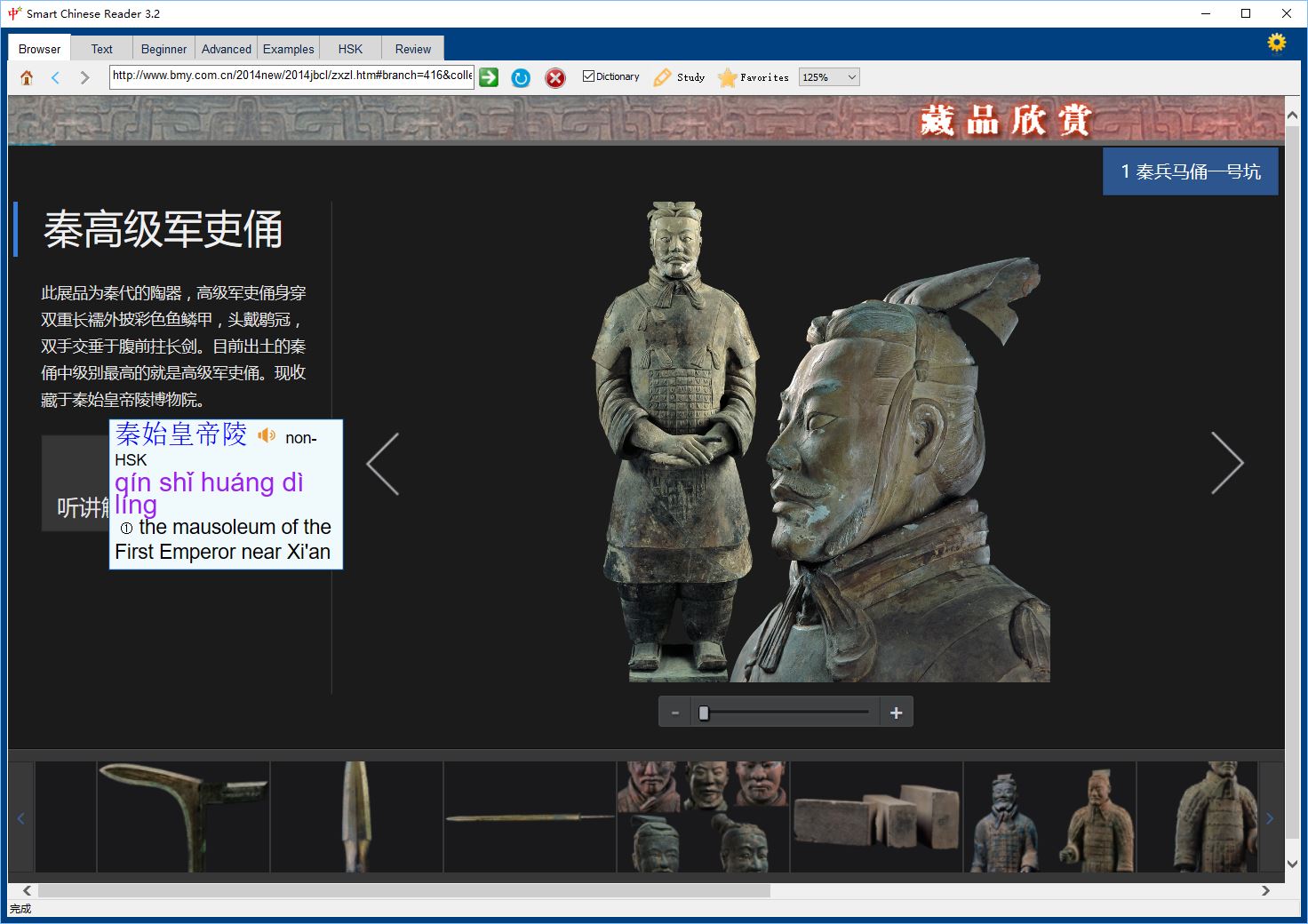
There are several ways to make your navigating easier. Click on the "Home" icon to go to the home page. Click on the "Go back" icon to go back to the previous page in the navigating history. Click on the "Go forward" icon to go forward to the next page in the navigating history.
The popup dictionary works only until the download of a whole page is completed. It may take a few minutes if the page has large images or you are on a slow internet connection. In such cases, once information you want has appeared, click on the "Stop" icon to stop loading the page to invoke the popup dictionary instantly.
Among pages you are browsing, you may find some are trivial while some are valuable, for practical use or for language learning. When you consider a section in a page worth a better understanding and want to study it in depth, select the section with your mouse, then click on the "Study" button. This brings up the Beginner and Advanced tabs, where the text is well formatted and easier to read.
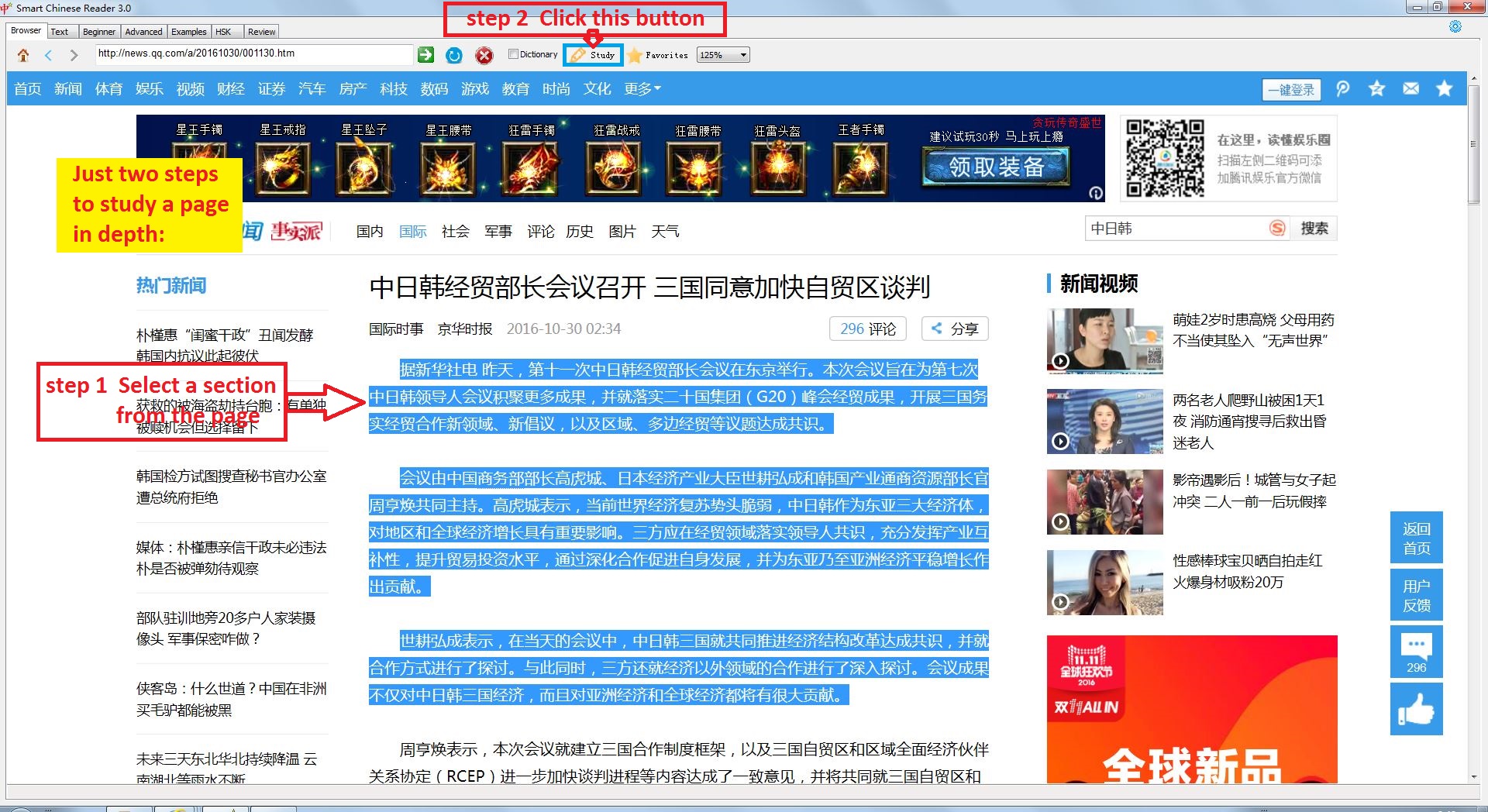
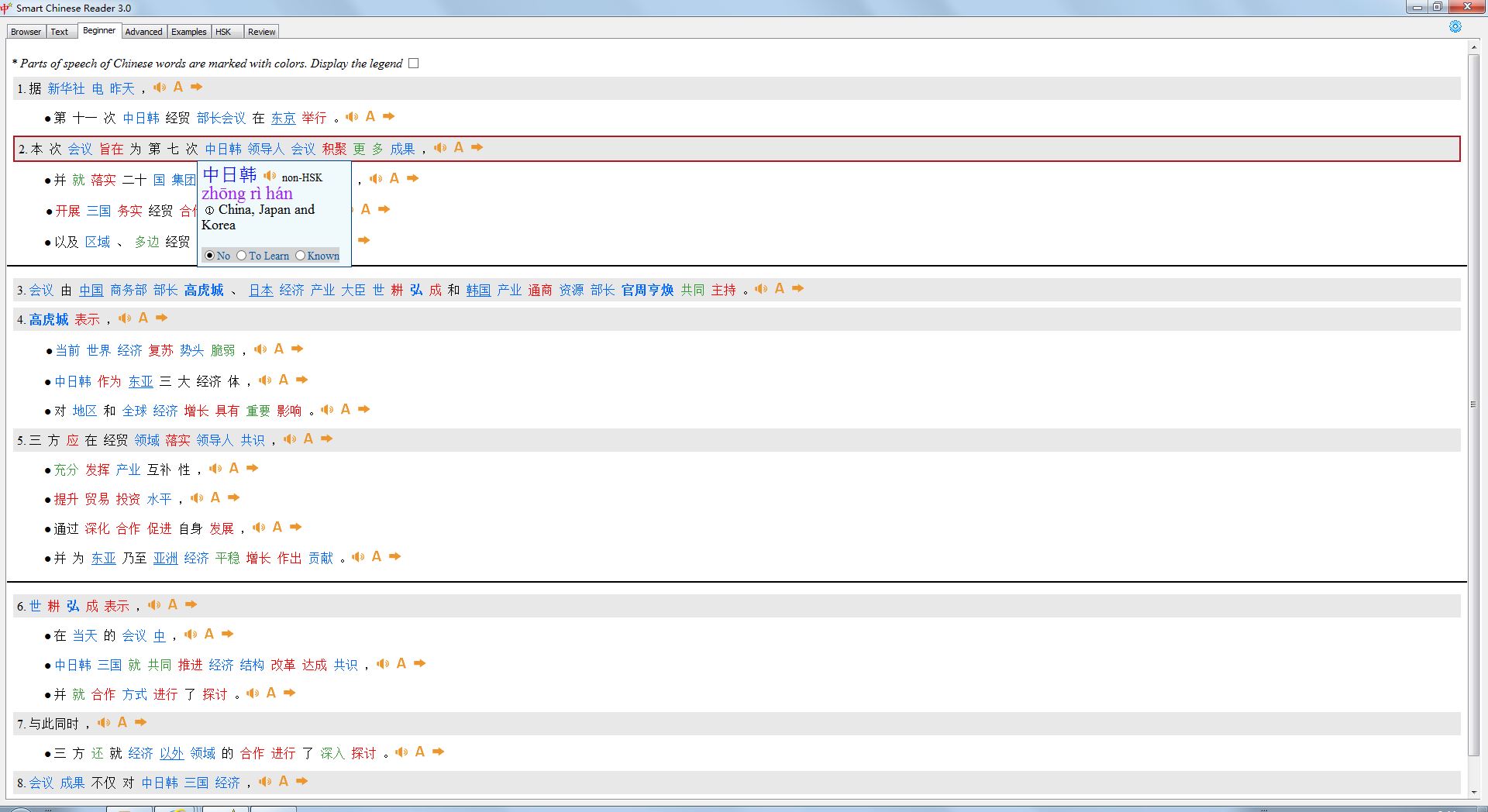
You may have difficulties selecting a block of text from a page when the popup dictionary is enabled. In this case, check the "Dictionary" checkbox off to disable the popup dictionary temporarily.
Click on the "Favorites" icon to bring up the Favorites dialog. You can set the site you're currently viewing as a favorite by clicking on the "Add" button on this dialog. Favorite pages are memorized and accessed directly in the future from the Favorites dialog. Just double-click on a favorite to visit it without reentering its URL. While adding a favorite, you can give it a name easy to recognize. Besides, if you don't like the default home page, you can select any other page and set it as your home page by clicking on the "Set Home" button in the Favorites dialog.
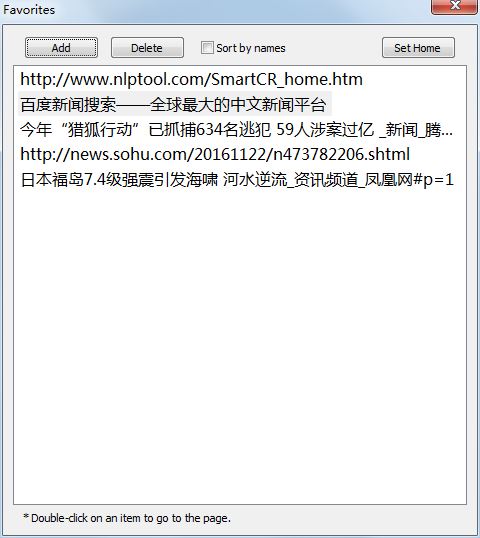
The "Zoom" dropdown list lets you make the screen display larger or smaller so that a webpage is easier to read. top
There are several ways to make your navigating easier. Click on the "Home" icon to go to the home page. Click on the "Go back" icon to go back to the previous page in the navigating history. Click on the "Go forward" icon to go forward to the next page in the navigating history.
The popup dictionary works only until the download of a whole page is completed. It may take a few minutes if the page has large images or you are on a slow internet connection. In such cases, once information you want has appeared, click on the "Stop" icon to stop loading the page to invoke the popup dictionary instantly.
Among pages you are browsing, you may find some are trivial while some are valuable, for practical use or for language learning. When you consider a section in a page worth a better understanding and want to study it in depth, select the section with your mouse, then click on the "Study" button. This brings up the Beginner and Advanced tabs, where the text is well formatted and easier to read.
You may have difficulties selecting a block of text from a page when the popup dictionary is enabled. In this case, check the "Dictionary" checkbox off to disable the popup dictionary temporarily.
Click on the "Favorites" icon to bring up the Favorites dialog. You can set the site you're currently viewing as a favorite by clicking on the "Add" button on this dialog. Favorite pages are memorized and accessed directly in the future from the Favorites dialog. Just double-click on a favorite to visit it without reentering its URL. While adding a favorite, you can give it a name easy to recognize. Besides, if you don't like the default home page, you can select any other page and set it as your home page by clicking on the "Set Home" button in the Favorites dialog.
The "Zoom" dropdown list lets you make the screen display larger or smaller so that a webpage is easier to read. top
2. Text Tab
Besides HTML pages, you may find texts interesting but you cannot fully understand them in other file formats, such as doc, pdf, ppt.
Don't worry, copy these paragraphs, and let SmartCR help you explore them.
For example, you have selected and copied the story:
李嘉誠于1928年出生在中國東南部的沿海城市潮州。12 歲為逃避戰亂,被迫輟學,與家人逃難到香港。他在不足15歲便到一個塑膠貿易公司上班,每天工作16小時。
憑借他的努力、謹慎及追求卓越的精神,李先生于 1950 年自行創立長江工業有限公司,最初經營塑膠製品,隨后李先生將公司發展成一個占据主導地位的香港物業發展公司,並于 1972 年在聯合交易所上市。長江分別于 1979 年及 1985 年透過收購和記黃埔有限公司及香港電燈集團有限公司(已易名為電能實業有限公司),持續進行業務拓展。
長江集團奠基于香港,業務包括物業發展及投資、房地產代理及管理、港口及相關服務、電訊、酒店、零售、能源、基建、財務及投資、電子商貿、建材、媒體及生命科技等。李先生深信眾志成城,從他將公司以「長江」命名便可體現他此一信念,因長江是匯聚百川的中國大河。
In the Text Tab of SmartCR, click the PASTE button, and this story is imported into the CHINESE TEXT textbox.
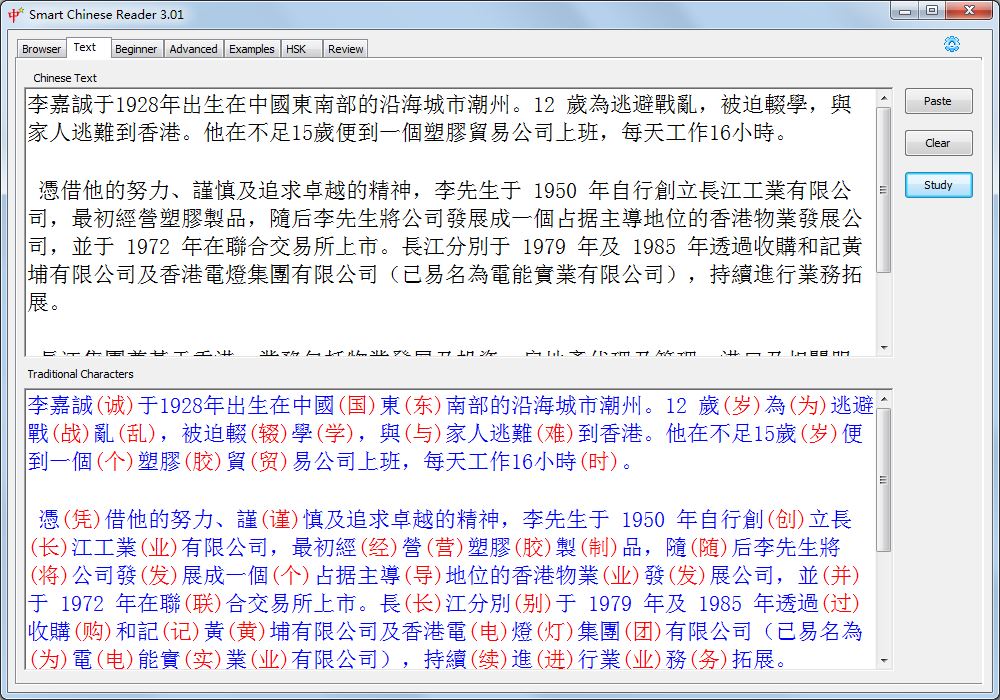
If there are traditional Chinese characters in the paragraphs, they will be detected and displayed in the TRADITIONAL CHARACTERS textbox with corresponding simplified Chinese characters.
Click the STUDY button, and a well-formatted text will be displayed in the Beginner tab.
Before importing a new text, click the CLEAR button to remove the content in the CHINESE TEXT textbox. top
李嘉誠于1928年出生在中國東南部的沿海城市潮州。12 歲為逃避戰亂,被迫輟學,與家人逃難到香港。他在不足15歲便到一個塑膠貿易公司上班,每天工作16小時。
憑借他的努力、謹慎及追求卓越的精神,李先生于 1950 年自行創立長江工業有限公司,最初經營塑膠製品,隨后李先生將公司發展成一個占据主導地位的香港物業發展公司,並于 1972 年在聯合交易所上市。長江分別于 1979 年及 1985 年透過收購和記黃埔有限公司及香港電燈集團有限公司(已易名為電能實業有限公司),持續進行業務拓展。
長江集團奠基于香港,業務包括物業發展及投資、房地產代理及管理、港口及相關服務、電訊、酒店、零售、能源、基建、財務及投資、電子商貿、建材、媒體及生命科技等。李先生深信眾志成城,從他將公司以「長江」命名便可體現他此一信念,因長江是匯聚百川的中國大河。
In the Text Tab of SmartCR, click the PASTE button, and this story is imported into the CHINESE TEXT textbox.
If there are traditional Chinese characters in the paragraphs, they will be detected and displayed in the TRADITIONAL CHARACTERS textbox with corresponding simplified Chinese characters.
Click the STUDY button, and a well-formatted text will be displayed in the Beginner tab.
Before importing a new text, click the CLEAR button to remove the content in the CHINESE TEXT textbox. top
3. Beginner Tab
You are taken to the Beginner tab after clicking the "Study" button in the Browser tab or the Text tab to study a section of text in depth.
The Chinese text has been segmented and is rendered at three levels to help you understand and learn it:
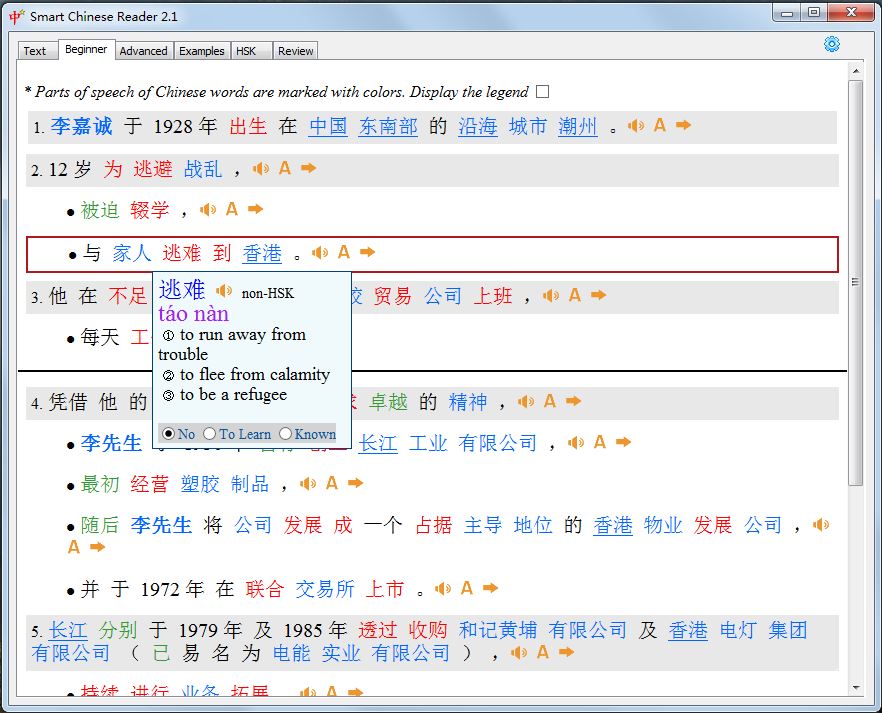
Besides word segmentation, the Beginner tab provides several learning aids for new learners of Chinese to understand Chinese words and expressions:
1) Color part of speech notation. Parts of speech (POS) of Chinese words in a sentence are marked with colors. The syntax structures of Chinese sentences are quite different from those of English sentences. With the color notation, you can familiarize yourself with the Chinese syntax in a short time. The legend of color POS notation is as follows:
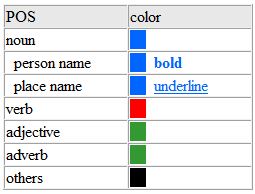
More ...
2) Chinese to English Translation: Clicking the "A" icon after a clause, its English translation is provided using the phrase-based statistical machine translation technology. While moving the mouse over each phrase in a Chinese sentence, the corresponding phrase in the English sentence is highlighted, and vice versa. This allows you to learn translation at the phrase level.
More ...
3) Text-to-Speech: SmartCR will read the clause aloud in Chinese if you click the SPEAKER icon after a clause. Smart Chinese Reader uses the state-of-the-art text-to-speech (TTS) technology. Given a sentence, SmartCR can pronounce it in various voices. For example, you will hear the sentence "李嘉誠于1928年出生在中國東南部的沿海城市潮州" read by Smart Chinese Reader in Microsoft HuiHui voice as:
To enable high-quality Chinese voices, a bit more effort is required. Detailed instructions on how to select voices are provided in this page Text-to-Speech Settings
4) Popup Chinese dictionary: To see the definition of a word, just click the word, and its dictionary entry will pop up. When a sentence's translation is shown, popup dictionary is disabled temporally for this sentence. You can hide the translation by clicking the "A" icon after this sentence once more to hide the translation. This recovers the popup dictionary.
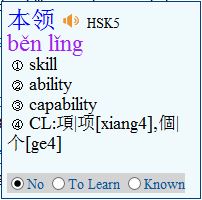
At the bottom of the popup dictionary, there is a learning state bar, which has three options:
In the Browser tab, press Ctrl + z to hear a word pronounced if you cannot move the mouse to the Speaker icon next to the word.
Word information shown in the popup dictionary comes from the CC-CEDICT dictionary from MDBG. For more information about CC-CEDICT see: http://cc-cedict.org/wiki/
More ...
5) Example sentence lookup: Double-clicking on a Chinese word will bring up the Examples tab in which example sentences containing the current word are provided. It is a rich source of information to learn the usages of this Chinese word, and serves as a good complement for the popup Chinese dictionary.
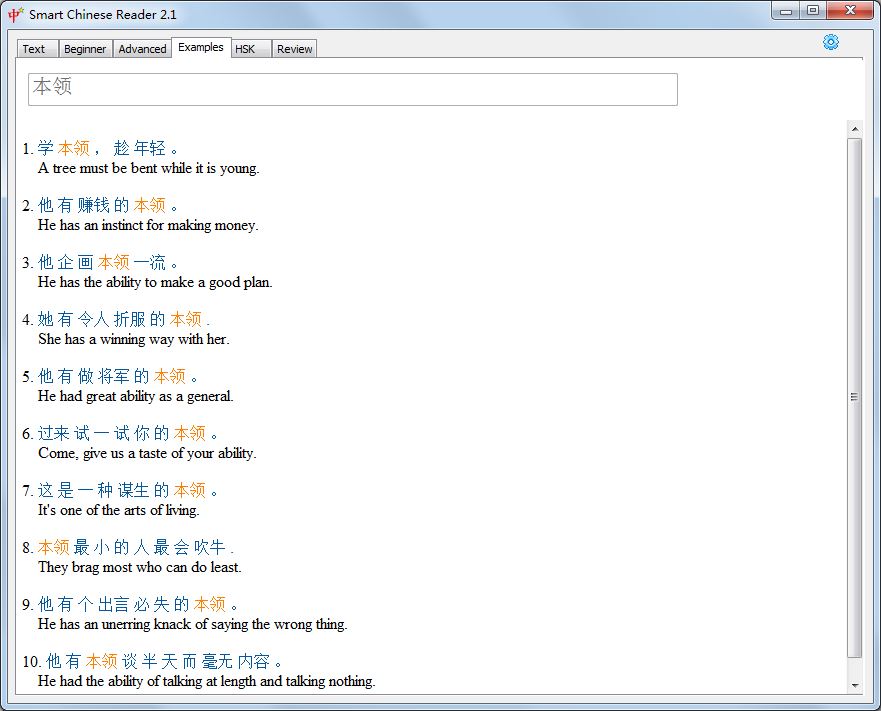
More ...
6) Changeable font sizes: The font sizes can be adjusted by the user. If you find Chinese characters or English characters are too small to read, you can enlarge them to 125%, 150% ... to make the text clearer. This is done in the Settings dialog, and will take effect in the next text segmenting. top
- sentence: Text is split into sentences in terms of delimiters 。,!:and ;
- clause: A sentence is split into clauses in terms of the delimiter ,
- word: The lack of word boundaries in orthography is a major obstacle in Chinese reading. SmartCR recognizes words from a clause using a state-of-the-art NLP (Nature Language Processing) technology. More ...
Besides word segmentation, the Beginner tab provides several learning aids for new learners of Chinese to understand Chinese words and expressions:
1) Color part of speech notation. Parts of speech (POS) of Chinese words in a sentence are marked with colors. The syntax structures of Chinese sentences are quite different from those of English sentences. With the color notation, you can familiarize yourself with the Chinese syntax in a short time. The legend of color POS notation is as follows:

More ...
2) Chinese to English Translation: Clicking the "A" icon after a clause, its English translation is provided using the phrase-based statistical machine translation technology. While moving the mouse over each phrase in a Chinese sentence, the corresponding phrase in the English sentence is highlighted, and vice versa. This allows you to learn translation at the phrase level.

More ...
3) Text-to-Speech: SmartCR will read the clause aloud in Chinese if you click the SPEAKER icon after a clause. Smart Chinese Reader uses the state-of-the-art text-to-speech (TTS) technology. Given a sentence, SmartCR can pronounce it in various voices. For example, you will hear the sentence "李嘉誠于1928年出生在中國東南部的沿海城市潮州" read by Smart Chinese Reader in Microsoft HuiHui voice as:
To enable high-quality Chinese voices, a bit more effort is required. Detailed instructions on how to select voices are provided in this page Text-to-Speech Settings
4) Popup Chinese dictionary: To see the definition of a word, just click the word, and its dictionary entry will pop up. When a sentence's translation is shown, popup dictionary is disabled temporally for this sentence. You can hide the translation by clicking the "A" icon after this sentence once more to hide the translation. This recovers the popup dictionary.
Popup Chinese-English Dictionary
The popup Chinese dictionary provides information including the word's HSK (Hanyu Shuiping Kaoshi, Chinese Proficiency Test) level, primary pinyin romanization and a concise English definition, alternate pronunciations and/or meanings, if any. Besides, the proper classifiers or measure words are given for this word, which are indicated with 'CL'. E.g. the classifier of 本领 is 项 or 个. To hear the word pronounced, click the SPEAKER icon on the popup dictionary.
At the bottom of the popup dictionary, there is a learning state bar, which has three options:
- No: No mark has been made on this word.
- To-learn: Mark the word as 'To-learn' if you need to relearn it later. Its occurrences will be highlighted with red border in the Advanced and HSK views. And it will be listed in the Review view, where you can improve and test your understanding of this word via quizzes on its definition and usages.
- Known: Mark the word as 'Known' if you can recognize it easily and understand its meaning. The word will be highlighted with blue border whenever it appears in the Advanced and HSK views to measure your mastery of a Chinese text or a particular HSK level.
In the Browser tab, press Ctrl + z to hear a word pronounced if you cannot move the mouse to the Speaker icon next to the word.
Word information shown in the popup dictionary comes from the CC-CEDICT dictionary from MDBG. For more information about CC-CEDICT see: http://cc-cedict.org/wiki/
More ...
5) Example sentence lookup: Double-clicking on a Chinese word will bring up the Examples tab in which example sentences containing the current word are provided. It is a rich source of information to learn the usages of this Chinese word, and serves as a good complement for the popup Chinese dictionary.
More ...
6) Changeable font sizes: The font sizes can be adjusted by the user. If you find Chinese characters or English characters are too small to read, you can enlarge them to 125%, 150% ... to make the text clearer. This is done in the Settings dialog, and will take effect in the next text segmenting. top
4. Advanced Tab
If your Chinese proficiency is at HSK level 4 or higher, you may find the Beginner tab is a little bloated and unnecessary, then switch to the Advanced tab.
The advanced view displays contents in the normal format of Chinese text, i.e., no spaces between words.
Users have to segment sentences by themselves.
However, if you are uncertain about the segmentation of one part of a sentence, just click on the part.
A Chinese dictionary will popup showing the word at the position with its definition.
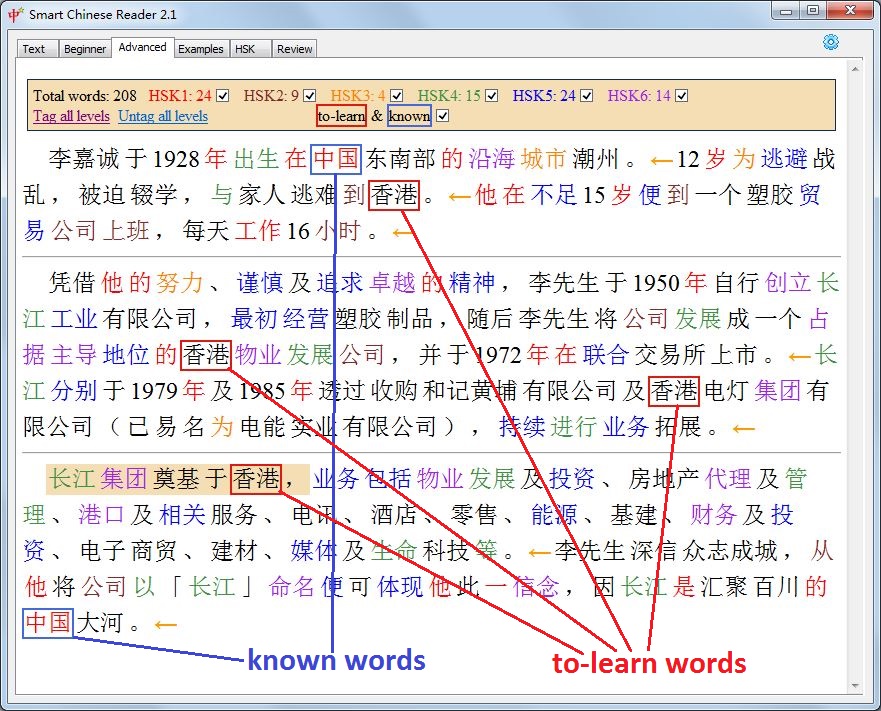
The learning aids provided by the Advanced tab focus on Chinese text analysis, and improving your Chinese reading skills:
1) statistics: The number of total Chinese words and words at different HSK levels (including HSK1, HSK 2, HSK 3, HSK 4, HSK 5, and HSK 6) are figured out. This gives you a measure of the difficulty of studying the document.
2) Color notation of HSK levels: Furthermore, words at different HSK levels can be marked in different colors. So colors in the Advanced tab have different meanings than in the Beginner tab, they are representing the HSK levels of Chinese words here. Check the checkbox next to a certain HSK level in the bar at the top of the view, words of this level will be displayed in the corresponding color. You should focus on words of lower HSK levels, and then move on to higher HSK levels. This helps you develop a learning plan, and makes your learning more productive.
3) To-learn and known words highlighting: To-learn and know words are highlighted in red and blue borders respectively. It shows your mastery of this text visually.
4) The popup Chinese dictionary is also available in the Advanced view.
5) Example sentence lookup is also available in the Advanced view.
6) Font size is also changeable in the Advanced view.
The Beginner view and the Advanced view of a sentence can be switched easily. Clicking the arrow after the sentence, you see it in another format. top
The learning aids provided by the Advanced tab focus on Chinese text analysis, and improving your Chinese reading skills:
1) statistics: The number of total Chinese words and words at different HSK levels (including HSK1, HSK 2, HSK 3, HSK 4, HSK 5, and HSK 6) are figured out. This gives you a measure of the difficulty of studying the document.
2) Color notation of HSK levels: Furthermore, words at different HSK levels can be marked in different colors. So colors in the Advanced tab have different meanings than in the Beginner tab, they are representing the HSK levels of Chinese words here. Check the checkbox next to a certain HSK level in the bar at the top of the view, words of this level will be displayed in the corresponding color. You should focus on words of lower HSK levels, and then move on to higher HSK levels. This helps you develop a learning plan, and makes your learning more productive.
3) To-learn and known words highlighting: To-learn and know words are highlighted in red and blue borders respectively. It shows your mastery of this text visually.
4) The popup Chinese dictionary is also available in the Advanced view.
5) Example sentence lookup is also available in the Advanced view.
6) Font size is also changeable in the Advanced view.
The Beginner view and the Advanced view of a sentence can be switched easily. Clicking the arrow after the sentence, you see it in another format. top
5. Examples Tab
The Examples tab can be accessed via double-clicking a Chinese word in the Beginner, Advanced, or HSK tab. This tab provides example sentences containing the current word.
Example sentences offer a wealth of information and give you a sense of how the Chinese word is used.
Each example sentence is a Chinese-English sentence pair, in which the Chinese sentence is original and the English sentence is its translation by human translator. Because sentences were originally conceived in Chinese, it ensures the authenticity of Chinese word usages.
More ...
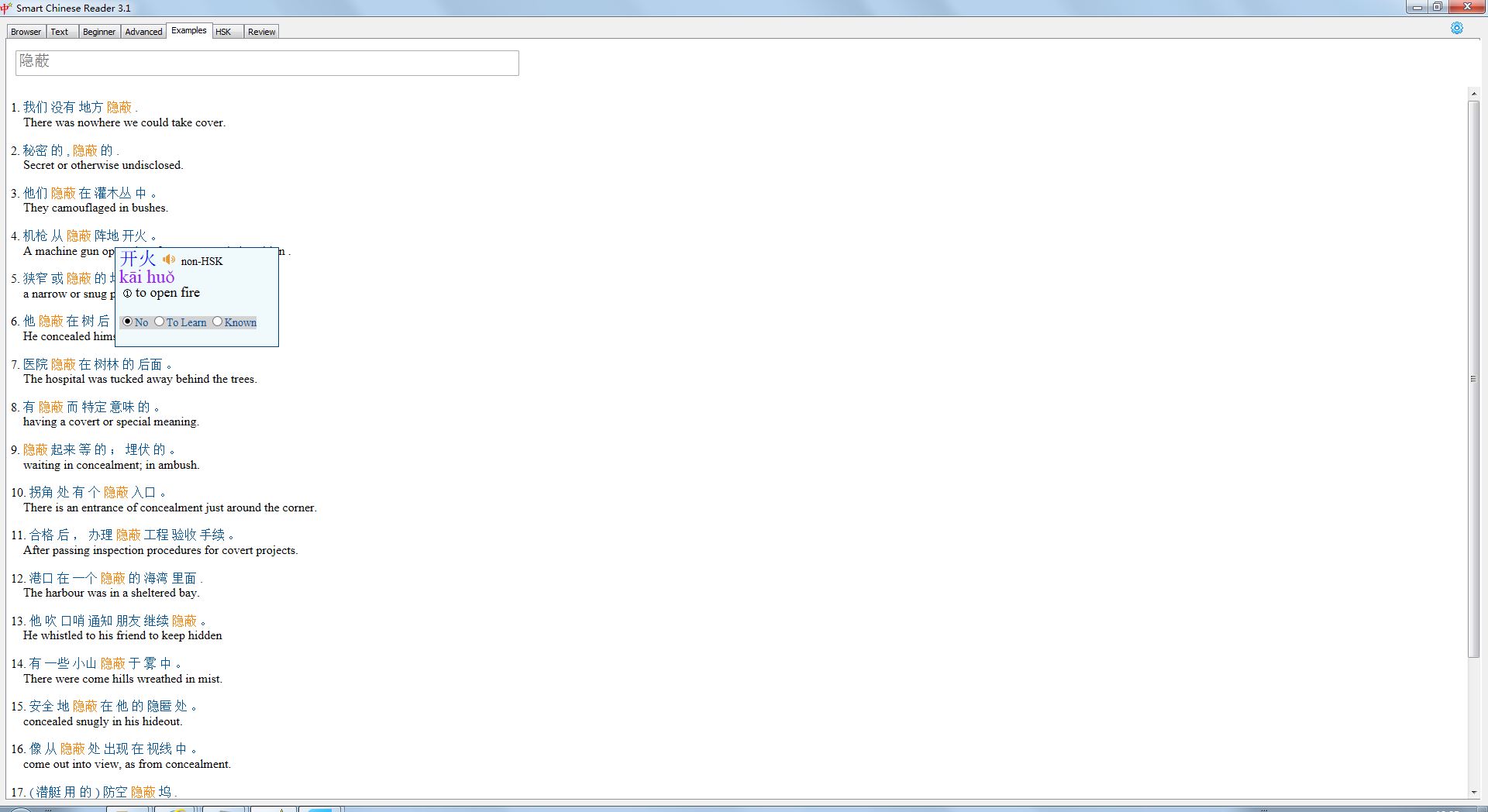
1) Example sentences are sorted by length.
2) The popup Chinese dictionary is also available in the Examples tab. For unknown Chinese words in the example sentences, just click on them to bring up the dictionary for help.
3) Font sizes are also changeable in the Examples tab. top
1) Example sentences are sorted by length.
2) The popup Chinese dictionary is also available in the Examples tab. For unknown Chinese words in the example sentences, just click on them to bring up the dictionary for help.
3) Font sizes are also changeable in the Examples tab. top
6. HSK tab
The HSK tab provides vocabulary and statistics of your known words for each HSK level (Hanyu Shuiping Kaoshi, Chinese Proficiency Test),
including HSK 1, HSK 2, HSK 3, HSK 4, HSK 5, and HSK 6.
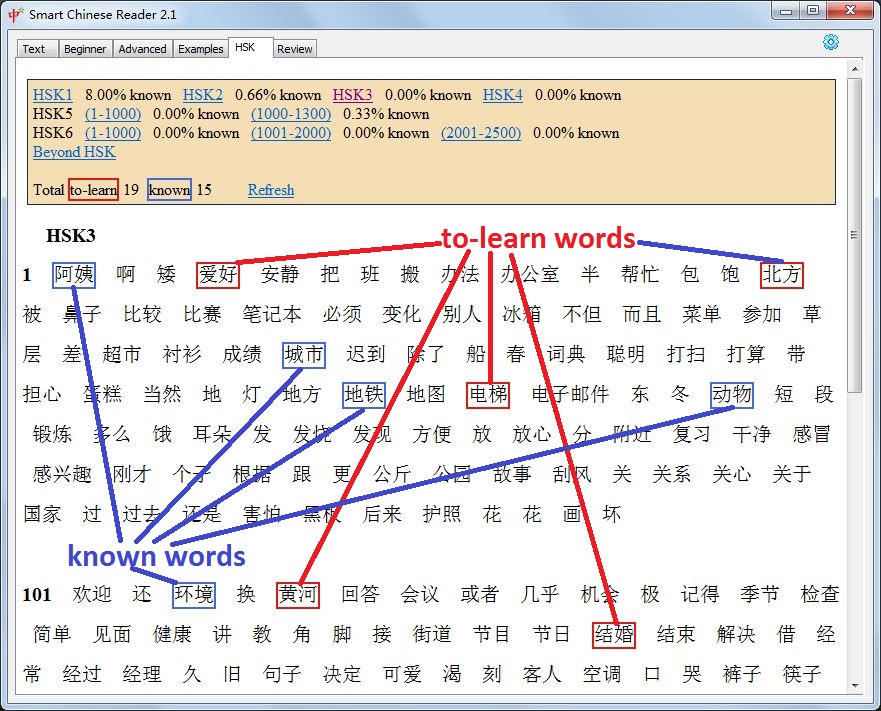
To-learn words are highlighted with red border and known words with red border in the vocabulary of each HSK level. It serves as a map clearly showing which HSK words you have been familiar with, which HSK words you haven't, and which HSK words you want to study further. For any HSK word you don't know, you can click on it to bring up the Chinese dictionary to see its definition, and double click to find its example sentences. This let you prepare HSK exam easily.
The percentages of known words at each HSK level indicate your mastery of Chinese words. Have you achieved the basic literacy of Chinese? Or have you reached an advanced level?
You can also mark any HSK word as 'To-learn' or 'Known' in the HSK tab. This is useful for constructing your to-learn and known word list when you run Smart Chinese Reader for the first time. top
To-learn words are highlighted with red border and known words with red border in the vocabulary of each HSK level. It serves as a map clearly showing which HSK words you have been familiar with, which HSK words you haven't, and which HSK words you want to study further. For any HSK word you don't know, you can click on it to bring up the Chinese dictionary to see its definition, and double click to find its example sentences. This let you prepare HSK exam easily.
The percentages of known words at each HSK level indicate your mastery of Chinese words. Have you achieved the basic literacy of Chinese? Or have you reached an advanced level?
You can also mark any HSK word as 'To-learn' or 'Known' in the HSK tab. This is useful for constructing your to-learn and known word list when you run Smart Chinese Reader for the first time. top
7. Review tab
The Review view serves as a flashcard system to strengthen your memory of to-learn words.
It lists words that you have marked as 'To-learn' by HSK levels,
on which you should drill yourself constantly.
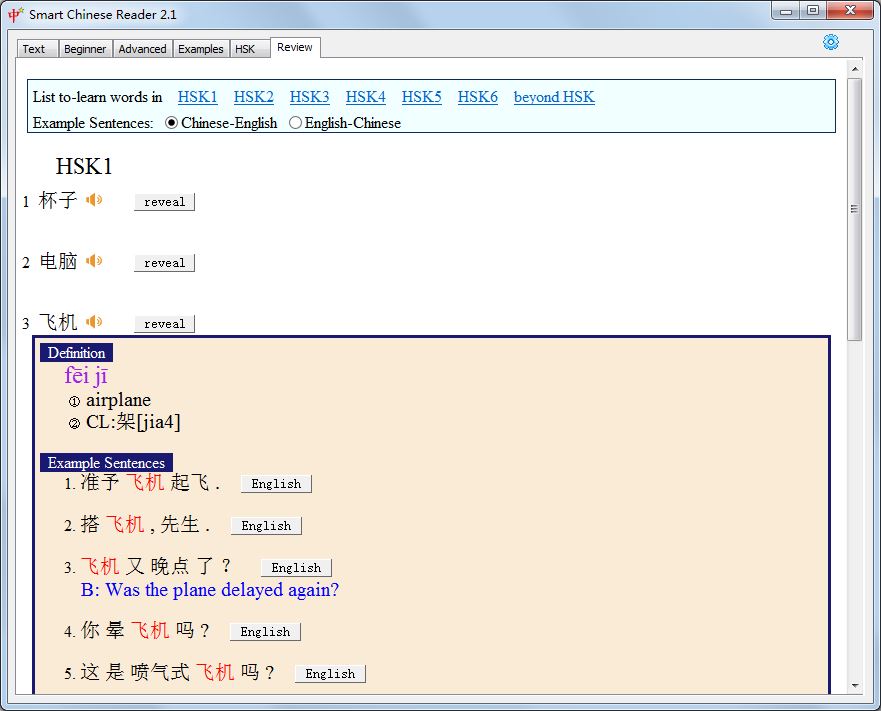
Try to recall the meaning of a Chinese word, and then click the "Reveal" button next to the word to see its definition. If you are right, good. Else you need to spend more time to restudy it.
More valuable, the example Chinese sentences containing this word are provided. Try to understand these sentences first. Click the "English" button to the right of the sentences to show their English expressions. Check if you have got the meanings of the Chinese sentences correctly.
You can set Smart Chinese Reader to display English sentences first, and want you to recall the corresponding Chinese sentences. This is more difficult than the Chinese-English quiz, but it is an effective way to build strong memories of how to use this Chinese word properly in particular contexts.
If you pass the test of a to-learn word successfully, it indicates that you have understood the word. You can remove it from the to-learn list by marking it as 'Known' through the popup dictionary. (Click on the head word to bring up the popup dictionary.) top
Try to recall the meaning of a Chinese word, and then click the "Reveal" button next to the word to see its definition. If you are right, good. Else you need to spend more time to restudy it.
More valuable, the example Chinese sentences containing this word are provided. Try to understand these sentences first. Click the "English" button to the right of the sentences to show their English expressions. Check if you have got the meanings of the Chinese sentences correctly.
You can set Smart Chinese Reader to display English sentences first, and want you to recall the corresponding Chinese sentences. This is more difficult than the Chinese-English quiz, but it is an effective way to build strong memories of how to use this Chinese word properly in particular contexts.
If you pass the test of a to-learn word successfully, it indicates that you have understood the word. You can remove it from the to-learn list by marking it as 'Known' through the popup dictionary. (Click on the head word to bring up the popup dictionary.) top
